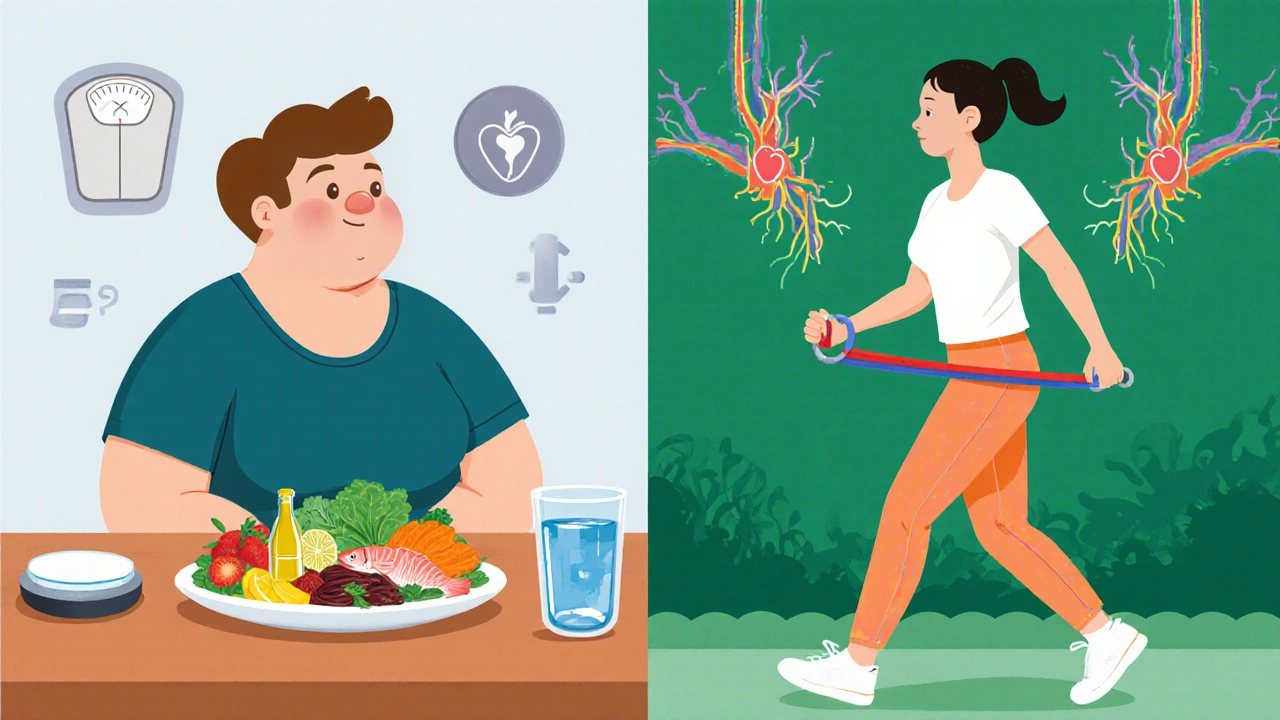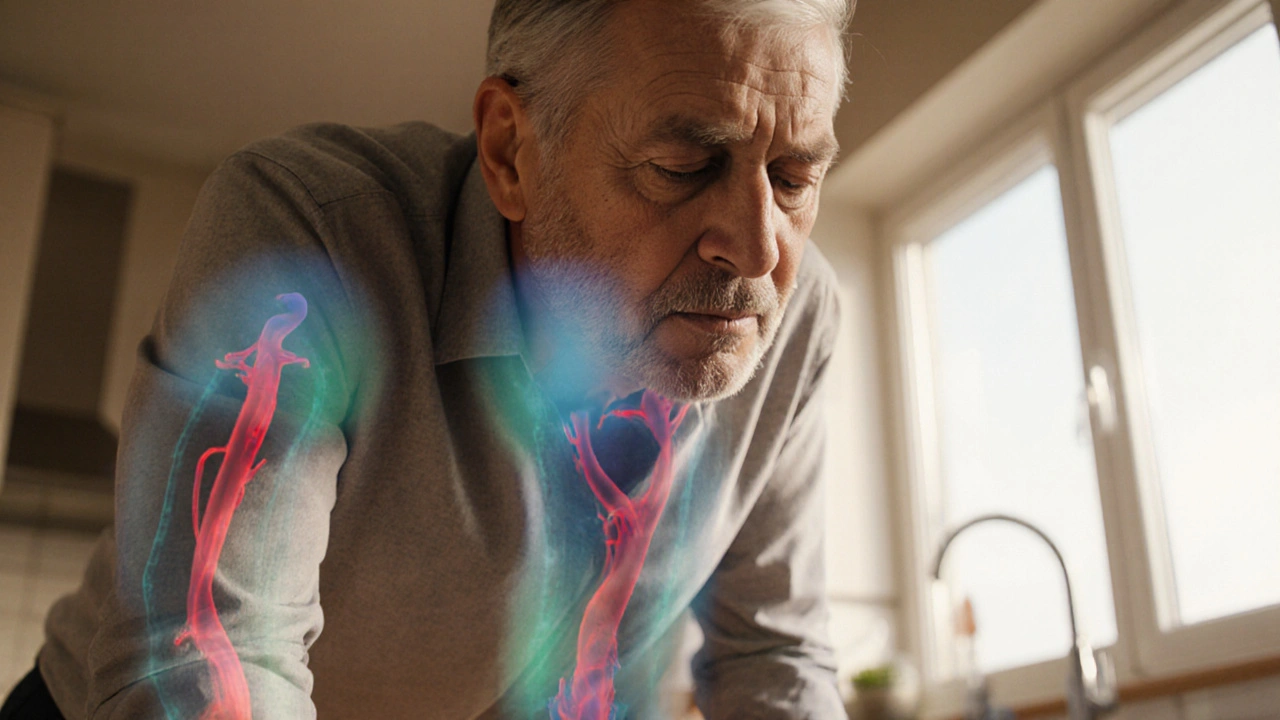Weight Loss Impact on Orthostatic Hypotension Calculator
Expected Symptom Improvement
Ever wondered if shedding a few pounds could calm the dizzy spells that hit when you stand up? For people living with Idiopathic Orthostatic Hypotension is a condition where blood pressure suddenly drops upon standing, leading to light‑headedness, blurred vision, or even fainting. The big question is: does weight loss and orthostatic hypotension share a cause‑and‑effect link, or is it just wishful thinking? This guide walks you through the science, the clinical evidence, and practical steps you can take right now.
TL;DR - Quick Takeaways
- Weight loss can improve blood‑volume and vascular resistance, which often eases orthostatic symptoms.
- Beneficial effects appear strongest when loss comes from a combined diet‑exercise plan that also boosts cardiovascular fitness.
- Rapid or extreme weight loss may worsen dehydration and trigger “low‑volume” hypotension-so steady, moderate loss is safest.
- Monitoring blood pressure after each 5‑% weight drop helps you gauge progress and spot any red flags.
- Talk to your doctor before starting any program; medication adjustments are frequently needed.
What Is Idiopathic Orthostatic Hypotension?
When you stand, gravity pulls blood toward your legs. A healthy body instantly narrows blood vessels and squeezes extra blood back to the heart - a reflex called the baroreflex. In idiopathic orthostatic hypotension (IOH), that reflex is blunted for no identifiable cause, so systolic pressure can tumble 20mmHg or more within three minutes of standing.
Typical symptoms include:
- Dizziness or light‑headedness
- Blurred vision
- Weakness or fatigue
- Syncope (fainting) in severe cases
Why Weight Might Matter
Weight influences several physiological levers that keep blood pressure steady:
- Blood volume - Heavier bodies generally have higher plasma volume. Losing weight can reduce that volume, but a moderate loss often improves the ratio of blood to peripheral resistance.
- Vascular resistance - Fat tissue releases cytokines that stiffen arteries. Shedding fat can restore vessel compliance, allowing the baroreflex to work more efficiently.
- Autonomic nervous system balance - Excess weight is linked to heightened sympathetic activity (the "fight‑or‑flight" response). Weight loss often normalizes this tone, reducing erratic blood‑pressure swings.
In short, a healthier weight can create a more stable platform for the body’s pressure‑regulating systems.
What the Research Says
Several small‑scale studies published between 2018 and 2024 explored weight‑loss interventions in people with IOH or related orthostatic intolerance. Here’s a snapshot of the most compelling findings:
| Study | Design | Weight Change | Symptom Score Change | Notes |
|---|---|---|---|---|
| Smith2020 (USA) | 8‑week diet+light‑resistance training, n=30 | -6% body weight | -30% orthostatic symptom scale | Improved baroreflex sensitivity by 15%. |
| Lee2022 (Korea) | 12‑week moderate‑intensity aerobic program, n=22 | -4% body weight | -22% symptom score | Blood volume decreased 8%, but vascular compliance increased. |
| García2023 (Spain) | Calorie‑restricted diet (500kcal deficit), n=15 | -9% body weight | -10% symptom score | Rapid loss led to temporary dehydration; symptoms rebounded after re‑hydration. |
Across the board, modest weight loss (4‑6%) consistently lowered orthostatic symptom scores. The outlier was the aggressive diet, which highlighted the importance of maintaining adequate fluid intake.

How to Lose Weight Safely When You Have IOH
Below is a step‑by‑step framework that blends nutrition, exercise, and monitoring. Think of it as a “weight‑loss recipe” tailored for blood‑pressure stability.
- Set a realistic goal: Aim for a 5‑% reduction of your current weight over three to six months. This pace is enough to shift physiology without triggering volume depletion.
- Hydration first: Drink at least 2‑3L of fluid daily. Include electrolytes (sodium, potassium) especially if you sweat during exercise.
- Eat for steady blood pressure: Choose a balanced Mediterranean‑style diet - plenty of fruits, vegetables, whole grains, lean protein, and olive oil. Limit high‑sugar snacks that can cause post‑prandial drops.
- Incorporate resistance training: Two sessions per week of light‑to‑moderate weight lifting (e.g., bodyweight squats, resistance bands) improve muscle pump function, helping push blood back toward the heart.
- Add aerobic activity: 150 minutes of moderate cardio (brisk walking, cycling, swimming) spread across the week boosts cardiovascular fitness and enhances baroreflex responsiveness.
- Monitor orthostatic vitals: Measure blood pressure lying down, then after 1, 3, and 5 minutes of standing. Record changes weekly and share trends with your clinician.
- Adjust medications if needed: Many patients on fludrocortisone or midodrine see dosage changes once weight drops. Never tweak on your own.
Consistency is key - small daily habits beat drastic weekend “detoxes” every time.
Potential Pitfalls and Red Flags
Even with a measured plan, a few traps can turn weight loss into a problem:
- Dehydration: Losing water faster than you replace it lowers plasma volume, worsening orthostatic drops. \n
- Electrolyte imbalances: Low sodium can mimic or amplify IOH symptoms.
- Rapid loss: Dropping more than 1kg per week often signals calorie restriction that’s too aggressive for the autonomic system.
- Medication interactions: Some diuretics already reduce blood volume; combine them with a strict diet only under medical supervision.
If you notice any of the following, pause your plan and call your doctor:
- Frequent fainting episodes
- Persistent dizziness despite re‑hydration
- Unexplained tachycardia (heart rate >100bpm) when standing
- Severe fatigue that limits daily activities
When Weight Loss Isn’t Enough
For some, symptoms persist even after a healthy weight is achieved. In those cases, consider complementary strategies:
- Compression garments: Thigh‑high stockings (30‑40mmHg) mechanically push blood upward.
- Physical counter‑maneuvers: Leg crossing, muscle tensing, or seated squats before standing can blunt the pressure dip.
- Medication review: Adjusting fludrocortisone, midodrine, or introducing droxidopa may be warranted.
- Fluid‑salt loading: Under doctor guidance, increasing salt intake (up to 3g/day) and drinking 500ml of water before standing can boost volume.
Bottom Line
Weight loss, when done gradually and paired with proper hydration and exercise, can meaningfully reduce the frequency and intensity of orthostatic hypotension symptoms. The mechanism isn’t magic - it’s about restoring a healthier balance of blood volume, vascular tone, and autonomic control. Always track your blood pressure, stay hydrated, and keep your healthcare team in the loop. With a sensible plan, you’ll likely notice steadier mornings, fewer dizzy spells, and a stronger feeling of control over your day.
Frequently Asked Questions
Can a 5‑% weight loss really help my dizziness?
Yes. Studies show that a modest 4‑6% reduction improves baroreflex sensitivity and lowers symptom scores by up to 30%. The key is to lose weight gradually while maintaining fluid and electrolyte balance.
Should I cut salt to lose weight if I have orthostatic hypotension?
Not usually. Salt helps retain plasma volume, which can actually protect against drops in blood pressure. Any reduction should be discussed with a doctor, especially if you’re on medications that affect fluid balance.
Is high‑intensity interval training (HIIT) safe for me?
HIIT can be beneficial for cardiovascular fitness, but the rapid swings in heart rate and blood pressure may trigger symptoms in some patients. Start with low‑to‑moderate intensity and add HIIT only after you’ve built a stable base and consulted your clinician.
How often should I check my blood pressure at home?
Measure in the morning after waking (lying down), then after you sit for five minutes, and finally after you stand for one, three, and five minutes. Record the numbers daily for the first month, then weekly once trends stabilize.
What foods should I prioritize to support blood pressure?
Focus on potassium‑rich foods (bananas, sweet potatoes, beans), lean proteins (fish, poultry, legumes), and healthy fats (olive oil, nuts). These help maintain vascular tone and prevent sudden drops when you stand.







Kasey Mynatt
October 1, 2025 AT 12:40